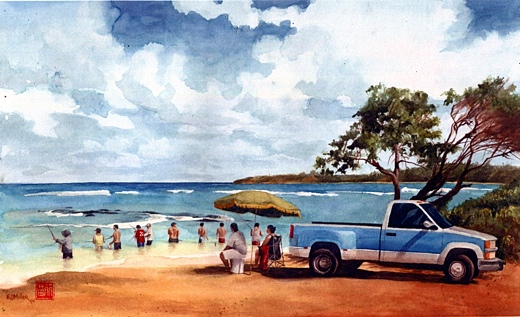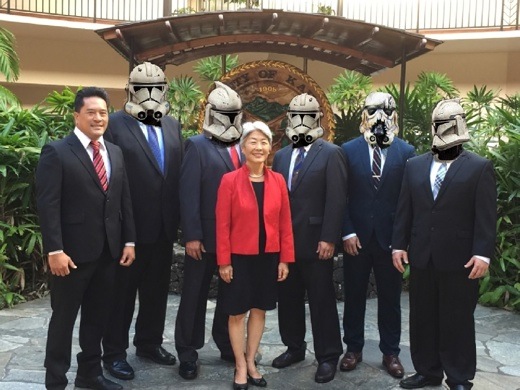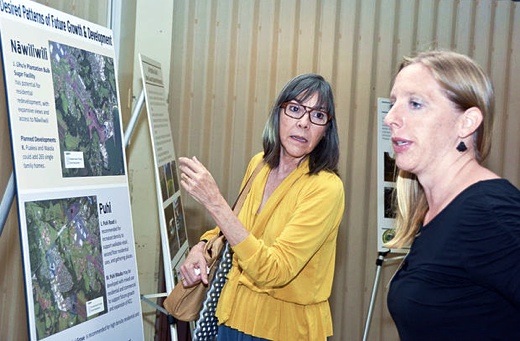SUBHEAD: Kauai County considers asking state of Hawaii for millions to fund public works programs.
By Juan Wilson on 12 November 2015 for Island Breath -
(
http://islandbreath.blogspot.com/2015/11/no-need-for-7m-from-state.html)
 Image above: Painting of typical "illegal" westside ohana beach scene by Emily Miller ~ 2006. Print scanned by Juan Wilson.
Image above: Painting of typical "illegal" westside ohana beach scene by Emily Miller ~ 2006. Print scanned by Juan Wilson.
Below is an article from the Garden Island News reporting on plans to consider asking the state of Hawaii for $7 million for "capital improvements", some to be directed to the Salt Pond area of the Hanapepe - Eleele area where I live.
My take on this plan is to suggest it be broken up into separate issues, and the overall plan to be abandoned. I admit to having conflicting opinions on some of the issues in the plan.
For example, I am against people driving for recreation along the shore break or off-roading in the dunes behind the beach. However, I see a need for residents to have access to beaches where there are not roads available (as illustrated in the image above).
Adolescent Treatment Facility
To begin with, it seems to me $5 million dollars from the state to house 8 beds of troubled teens seems inappropriate.
Essentially, the state sponsored adolescent treatment facility will be a minimum security prison. Over the last decade Kauai communities have rejected every attempt to site such a facility.
Here in Hanapepe the community pushed back on the plan to convert the former Humane Society facility on Lolokai Road near Salt Pond Beach Park. Similar rejections occurred in other suggested communities on Kauai. Can't Kauai communities find some more humane way to take care of eight of its own children?
Veteran's Cemetery Improvements
This cemetery, located on Lele Road, is near Salt Pond Beach Park. It is one of several cemeteries in the area. There is the Hawaiian, the Chinese, and the Filipino Cemetery, the last of which is adjacent to the Veteran's site.
Neither the state or county take any interest or provides any maintenance for these other facilities and it shows. Why doesn't the County Council see a need in these other near?
According to the National Cemetery Administration the cemetery is owned and operated by a State of Hawaii. The state has not applied for and received a Veteran's Administration grant to establish, expand or improve this veterans cemetery.
Perhaps the Kauai County Council ask the state of Hawaii to apply for such funding to achieve the county's improvement goals.
It should be noted that this cemetery just completed a major improvement with a new garage and shop facility and major landscaping.
Centralized Vehicle Maintenance
Over time I think it will only make sense not to have single county facilities for services like the landfill, or a single vehicle maintenance facility. It may have some economic advantage today, but over time that will not be the case.
The idea that every bag of Hanalei kitchen garbage must require a trip around the island by twenty-ton truck will seem increasingly wasteful. So is driving a public works truck around the island for an oil change.
Besides the wasted energy, pollution and traffic congestion there is the damaging impacts of such trucks have on our roads can be measured using an Equivalent Single Axle Load (ESAL) formula. A standard passenger car has an ESAL of .0007, while a 3-axle garbage truck has an ESAL of 1.0. This means one trip by a 3-axle garbage truck is equivalent to 1,429 car trips. See (
http://www.titanrecycleandtrash.com/garbage_trucks_on_your_roads).
County and state services should be spread out regionally on the island, not centralized. Again, why should anyone have to drive from Kekaha to Lihue to renew a driver's license.
Salt Pond Master Plan
This ancient Hawaiian salt gathering site is on land "owned" by the State of Hawaii. Up until the 1960's it was used, maintained and operated by independent Hawaiian families.
Other ethnic groups became part of this community over the last century - Japanese, Filipinos, Portuguese, etc. Some time in the early 60's a group of families organized a hui (group, club, partnership, union, gang) to manage the Salt Pond area. The hui insisted that all of the families join them and pay an annual dues or lose their right to gather salt.
Some local families stayed and defied the hui. Politics continue to exist at Salt Ponds. It is my opinion that the proposed "improvements" for Salt Pond may be related to these politics and will have an negative effect by institutionalizing and officiating by the government of real Hawaiian ways of doing things.
The Salt Pond gathering area is bounded on the north by the approach from Lokolai Road, on the east by Kaalani Road and on the south by Kuiloko Road. There is a parking lot at the west end of Kuiloko Road that is used by many of the Salt Pond gatherers.
When my wife and I moved to Kauai in 2001, the area between the Hanapepe Airport fence and Salt Ponds was open and wide. People drove through this area to reach the beach from the west end of Kuiloko Road.
Particularly in the winter this area would be flooded by salty rain water. People would splash through the area in four-wheel drive to reach the beach to the west to hang out at sunset. Some people believed this traffic could contaminate the Salt Ponds. An effort was made to control this traffic by laying down a string of large boulders to contain this traffic near the airport fence line.
This seemed a pretty good solution to me. The law of the state does not allow access onto the beach by automobiles. However, I believe that people should not drive along the beach but should be able to reach the beach with there vehicles.
This position kind of straddles the current rules. Keep in mind that the state, the military and the rich keep reducing the areas that can be accessed for recreation, hunting and fishing for the rest of us. Why else would we live here without access to the beach?
Up until 2001 westsiders had four-wheel access from Kekaha to Poli Hale - the longest stretch of beach in the state of Hawaii. Surfcasters, campers, off-roaders used this access everyday until the World Trade Centers came down.
The PMRF cut that off then and continues to do so to this day as a matter of "security". The upside is that surfcasters will tell you that the fish that were waning are back in force along this stretch of beach.
The beach driving law is flaunted in a number of locations, like Poli Hale, Hanalei Black Pond Beach, Kekaha Beach, etc. For many on the westside car access to the beach is a way of life. It is a primary element in recreation for many families. Friday nights along the southern shore of Salt Pond Beach includes dozens of families that eat, party and relax together every week.
The current discussion about Salt Pond by the county includes blocking off the beach to automobile traffic altogether. That will not be popular.
Problems related to access for recreation and conflicting the state laws are not resolved.
Problems at the top
Back in 2006 then mayor Bryan Baptiste was interested in building a large stadium at Puolo Point on the state land south of Hanapepe Airport that would have included a drag strip. He told the community that the county could have use of the land, on a long term lease for a $1 and acre per year from the State Department of Transportation.
Nadine Nakamura, a planner, was hired as a "facilitator" for a meeting with the "community" at Eleeele Elementary School. This plan was a very unpopular idea in the community. Neighbors overwhelmingly wanted that area left alone.
No parking, no public restrooms, no stadium or drag strip... just nature and access to it. Nadine was smart enough to see what the people wanted and did not try to jam Baptiste's plan down our throughts. She, in fact, encouraged the community to act itself to determine Puolo Point's future. Baptiste was so upset that he ended the meeting telling the community that if they did not want his plan he would reject the lease offer from the state.
Since then there has been some change to Puolo Point. A helicopter chartering company illegally built a hanger and refueling station without a Special Management Area shoreline permit that was required.
A few homeless people have camped there for a while. The response of the State Department of Transportation was to put up "No Trespassing" all along the Ala Loa trail used by fishermen and the community. The fact is it is hard to camp there for long due to flying roaches, stinging ants and strong winds.
I suspect that if the state gets more involved with the Salt Pond, Puolo Point area that there will be a greater reduction of access for all of us.
Nadine Nakamura was voted onto the Kauai County Council a few years back. I supported her and voted for her. In 2013 there was great controversy over Gary Hooser's bill to manage pesticide use by Big Ag. Bill 2491 was eventually passed after modification by Nadine and JoAnne Yukimura, who both supported the bill.
Nadine was hired by the mayor as County
Managing Director, a $100K position and left the council, right at the time of the crucial vote. Mayor Carvallho then vetoed the bill but it was eventually overridden by the Council. This was only because Mason Chock, who also supported the bill, was approved as Nadine's replacement just in the nick of time before the vote.
My point is, that Nadine is going to be the mayor's hammer on this $7 million dollar set of proposals. She will not likely to be the same woman I admired in 2006 as an advocate of the community.
See also:
Island Breath: Puolo Point Plan Meeting 5/26/06
Ea O Ka Aina: Bill 2491 into the home stretch 9/2/13
Ea O Ka Aina: GMO Bill 2491 Endgame Strategies 9/26/13
Ea O Ka Aina: GMO Bill 2491 Morphs 10/4/13
Ea O Ka Aina: Nakamura to replace Heu 10/14/13
Ea O Ka Aina: GMO Bill 2491 passes 6-110/16/13
County may seek $7M from State
By Jesica Else on 10 November 2015 for the Garden Island -
(
http://thegardenisland.com/news/local/govt-and-politics/county-may-seek-m-from-state/article_f415d75b-06df-5f1a-8c8d-1d309f6a4d06.html)
 Image above: New "No Trespassing - No Camping" DOT sign at Puolo along the Ala Loa trail at Point in August of 2013. Isn't this a place where people should be able to camp and fish. Photo by Juan Wilson.
Image above: New "No Trespassing - No Camping" DOT sign at Puolo along the Ala Loa trail at Point in August of 2013. Isn't this a place where people should be able to camp and fish. Photo by Juan Wilson.
The County Council is discussing a list of projects that will go
before the state Legislature for potential general obligation bond
funding opportunities.
There
are five projects on the Capitol Improvement Project funding list — $5
million for an adolescent treatment and healing center, $550,000 for a
centralized auto maintenance facility, $400,000 to go toward the Salt
Pond master plan, $500,000 for a helicopter hangar for the Kauai Fire
Department, and $700,000 for construction and improvements at the
Veterans’ Cemetery facility.
Nadine Nakamura, county managing director, and Keith Suga, county CIP manager, presented the five projects to the County Council.
The council ultimately decided the list needed further discussion in committee meetings before it is revisited at the next council meeting Nov. 18.
“I’m not adverse to anything on this list; however, I am not supportive (of approving this list) on the fact that there is more work that needs to be done on some of these items,” said Councilmember Mason Chock. “I am looking forward to having a more in-depth discussion on this and see how we can move forward with this list.”
The council was in full agreement with having the helicopter hangar, the Salt Pond master plan and the Veterans’ Cemetery facility on the list, but members needed more clarification on the other two items. Some councilmembers said they were hoping to see different things included on the list altogether.
“You look at the list and think it’s all worthwhile projects, but I ask where is the housing and the traffic and the roadway improvements?” Councilmember Gary Hooser said. “Then you start to see what is lacking and as I understand, general obligation bonds can be used for just about any capitol improvement project.”
Rep. Daynette Morikawa said Monday that Kauai has done “very well” when it comes to securing state funding, and she’s optimistic that the county will get some money from the legislature this year.
“It is always tough to get projects funded, but we, the Kauai Legislators, do our very best to work as a team in supporting all Kauai requests,” Morikawa said.
Salt Pond Master Plan
On the current list, there is a request for $400,000 for a master plan project to look at how to preserve the salt making culture on Kauai.
“The Salt Pond master plan is necessary to protect the salt beds and plan for better use of facilities which will preserve open space and allow for cultural information and history,” Morikawa said.
Director of Parks and Recreation Lenny Rapozo said there are several projects in the works at Salt Pond through Public Works, and this is a separate project that takes a look at how the county administration is working with area residents and families.
“This project is dealing with the stewardship of the salt makers,” said George Costa, director of the county’s Office of Economic Development. “We know that vehicles and people are in the salt area and part of the master plan is to discuss it with the families (so we can preserve the salt ponds).”
Costa said the department has looked at blocking off the beach to traffic, building a platform so folks can view the salt ponds without disturbing them, and adding salt-making demonstrations in the park.
“The goal is to work very closely with the community advisory group, and there will be multiple meetings to get a product that everyone can feel good about and sets a clear vision about what can happen in this area,” Nakamura said.
Adolescent Treatment and Healing Center
The plan asks the Legislature for $5 million to build an adolescent treatment and healing center on Kauai.
There are drug and alcohol treatment centers for adolescents on Neighbor Islands, but there isn’t a 24-hour facility on Kauai.
The center is in its beginning phase, with one feasibility study conducted in 2013 and an update in the works.
It would be a cluster of buildings that would be residential and a facility for group therapy, then there would be classroom space, Nakamura said. There will be about eight beds in the facility.
Councilmember JoAnn Yukimura questioned whether the administration had fully thought through putting the treatment center on the general obligation bond list.
“Isn’t it premature to be asking the Legislature for money before you have even the basic information about how this building is going to be used and operated?” Yukimura asked.
Hooser said he didn’t think there was a very high likelihood of the center receiving funding because there’s such a high demand for money from the Legislature.
Councilmember Ross Kagawa, however, said he thought the center should remain on the list.
“I’d rather have the state pay the $5 million than the county because it’s the state’s job anyway,” Kagawa said. “Our youth are better served here on the same island as where they live.”
Centralized auto maintenance facility
Currently there is one Public Works auto shop, built in 1978, that supports all 180 of the Kauai Police Department vehicles, which are among about 450 vehicles in various departments. The shop also supports the transportation and bus system’s growing fleet.
“The idea here is to create a centralized shop that would house repairs, not only for all of what Public Works currently does, but also the transportation agency’s units,” Suga said.
Suga said the idea is to also incorporate the fire department’s maintenance needs at the new facility.
Yukimura said the idea was basically sound, but she thought more emphasis needs to be put onto the transportation department’s buses.
“I’m concerned about transportation not getting the priority it needs to keep things up and running,” Yukimura said. “People need those buses to get to work.”
Last year, Kauai County got about $5 million in general obligation bonds from the state, and councilmembers said they thought it was reasonable to expect around the same amount again.
“If the Legislature has $4 million to give us, they’ll decide which project to fund,” Kagawa said.
He suggested that the County Council take a look at the current list and bring their own ideas forward throughout the week, so that the list is backed by a united front when it goes before the Legislature.
The County Council has set a deadline of Nov. 27 for the package, which gives them about three weeks for final approval. The list will be in committees until the next council session, where it will again be on the floor for discussion.
.










